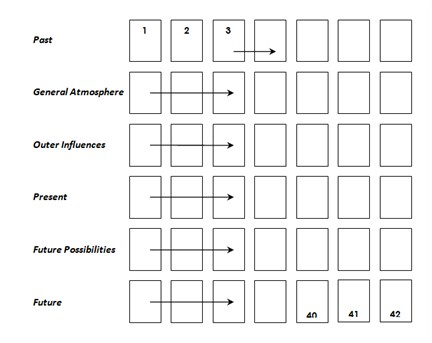What is the Gypsy Tarot Spread
After the questioner has handed me the shuffled cards, I proceed to lay the top cards out on the table, starting from left to right, in the pattern of the Gypsy Tarot spread, which is comprised of forty-two cards arranged in six lines with seven cards in each. The first line represents the Past, the second the General Atmosphere of conditions surrounding the question, and the third the Outer Influences. The fourth line shows the Present, the fifth, the Future Possibilities, and the sixth, the Future.
Remember that we will begin by using only the three lines of the reading: the Past, the Present, and the Future lines for the simple reason that beginning with Forty-two cards can be overwhelming. The overall layout of the Gypsy Tarot appears as follows:

The Gypsy Tarot Spread is well suited to the Synergy method of reading because of the high number of cards it incorporates into the reading. Most spreads use ten to sixteen cards, and while these layouts may be useful in providing quick yes and no answers to specific questions, the Gypsy spread presents a selection of cards large enough for the reader to grasp a broader insight into the situation concerning the questioner and the people who are key players.
I see the process of reading cards as a form of storytelling in which I take the details presented in the cards and intuitively string them together to generate a continuous narrative about the questioner and his life. The Gypsy layout helps make that process easier by providing a well-defined framework with a beginning, middle, and end in the form of the past, present (including the General Atmosphere, Outer Influences, and Present lines), and future (including the Future Possibilities and Future lines). After you accomplish using the Past, Present, and Future lines, you can start using the other three lines at the appropriate locations to even extract more detail from your readings. This is a complete reading.
I read the timeline in the Gypsy Spread as six months into the past, and six months into the future; otherwise, too many other issues tend to appear, confusing the main issue. If the questioner thought about a specific incident six months ago, it quite often presents itself early in the past line, and I know that the reading has a limited timeframe. Most times, the future will not expand beyond the timeframe indicated in the past. Calculate the number of days it has been since the incident occurred and divide it by the number of cards left in the line. You have just created the timeline that you can use in the future to determine when an event appearing there may occur. Learning to distinguish the positions of the cards and their contextual meaning in the overall reading is the first step in interpreting the cards.